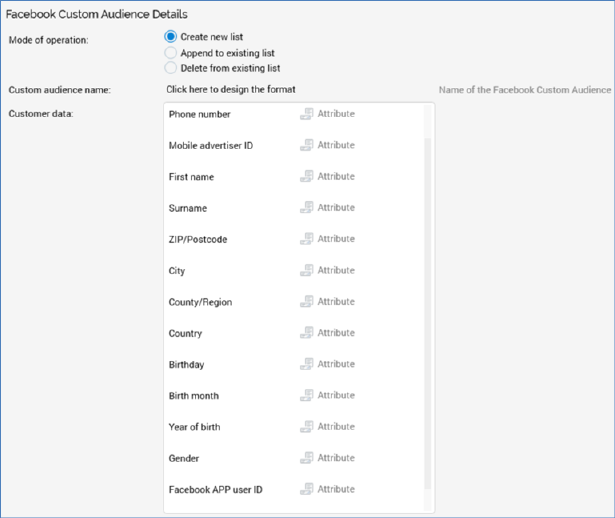
This section is displayed when Facebook action is set to Custom Audience. It contains the following:

•Mode of operation: three radio buttons accompany this property:
o Create new list: this option is selected by default. When selected, Channel, Synchronize with Facebook and Custom Audience are hidden, and Custom audience name is shown. When this option is selected, uploaded users will be added to a new custom audience (unless a custom audience with the name provided already exists)
o Append to existing list: when selected, Channel, Synchronize with Facebook and Custom Audience are shown, and Custom Audience name is hidden. When this option is selected, uploaded users will be appended to an existing custom audience.
o Delete from existing list: when selected, Channel, Synchronize with Facebook and Custom Audience are shown, and Custom Audience name is hidden. When this option is selected, uploaded users will be deleted from an existing custom audience
•Custom audience name: you can specify the name of a new Facebook custom audience to be created at offer execution using the Design Custom Audience Name Format dialog. The following text parts are supported:
o String
o Date part
o Age range (requires Year of birth attribute to be provided at the Customer Data property)
•Channel: this dropdown field is shown when Mode of operation is set to Append to or Delete from existing list. It is accompanied by, and populated on invocation of, a Synchronize with Facebook button. Clicking the button populates the field with a list of available Facebook Custom Audience channels.
•Custom Audience: this editable combo box accompanies, and its dropdown values are populated at the same time as, Channel. It facilitates selection or specification of a Facebook custom audience to or from which user data will be appended or deleted (note that a manually-specified Custom Audience must exist in the list).
•Customer data: this property is pre-populated with a list of Facebook field names. Each can be mapped to an RPI attribute file (using browse or drag and drop). Having mapped a field to an attribute, the attribute's details can be viewed in the File Information Dialog; the selection can also be cleared. At least one field must be mapped to an attribute.
The ‘Limited Data Use’ field can be used to map a Boolean attribute, which controls whether a record is subject to Facebook’s feature of the same name. Its mapping is mandatory when ‘US states’ has been mapped to an attribute (and vice versa).
•App IDs: this text field is visible and mandatory when the Facebook app user ID field is mapped to an attribute. It allows you specify a comma-separated list of the Facebook app IDs associated with the Facebook app user ID.
•Page IDs: this text field is visible and mandatory when the Facebook page user ID field is mapped to an attribute. It allows you specify a comma-separated list of the Facebook page IDs associated with the Facebook page user ID.